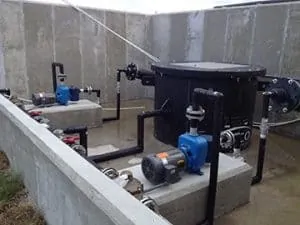

Equipped with wheels, the pumps roll down the riser pipe positioned in the horizontal portion of the pipe at the bottom of the sump. A discharge line from the pump extends up through the riser pipe, and after exiting the riser pipe at the top of the berm, connects to a leachate force main in the perimeter berm.
Maintenance of Submersible Pumps
To access the pump, the entire pump assembly, including the power cable connected to the pump, level control leads, discharge line, and the pump is removed from the riser pipe. The entire pump assembly is usually soiled with leachate and slime sticking to pipes, lines, and the pump while submerged.
Depending on the depth of the landfill from the top of the perimeter berm, the discharge lines could be long. A technician is handling the extraction of a long and heavy pipe, connected to a heavy pump at the lower end of the pipe to extract it from the rise pipe may have trouble.
Maintenance Technicians
A well-trained maintenance technician, particularly in the safety aspects involved in submersible pump maintenance is necessary. When removing a submersible pump for maintenance, having more than one technician is safer, and could be more cost-effective. Environmental aspects of maintenance work are also important, for example, the structure located at the top of the berm, where the riser pipes and leachate piping are located, should remain watertight. Otherwise, during maintenance, the liquids generated will escape into the berm structure and the environment.
Self-Priming Pumps

Self-priming pumps come in all sizes, are less expensive than the submersible pumps, and install easily inside the structure at the top of the perimeter berm using a 2-inch line extended to the bottom of the riser pipe for leachate removal.
Maintenance of self-priming pumps is significantly less cumbersome than submersible pumps. One technician can handle replacement or maintenance of the pump in a shorter period. The work is not necessarily as dirty a job either, because the technician is not handling significant amounts of leachate and slime.
Self-priming pumps are designed to prime easily after each maintenance session. On the pump is a check valve on the intake, and another near the bottom of the leachate removal pipe. The check values prevent any liquid inside the pump and the pipe from flowing back down to the sump when the pump is off. This benefit also prevents the need to prime the pump when it cycles back on.
Self-priming pumps are useful for double-lining systems equipped with a secondary sump and a primary sump. In areas where freezing conditions occur, the pumps can be used as long as the pumps, and the exposed piping is located inside an enclosed housing to prevent frost damage.
I’ve used self-priming pumps in applicable designs with sufficient performance. Even when utilized in very large pumping networks the results are as good. Testimonials from my clients regarding ease of maintenance and lower capital costs for system construction are positive.
After more than 20 years, that’s a good track record for continued use in the future.

Ali Khatami, PhD, PE, LEP, CGC, is a Project Director and a Vice President of SCS Engineers. He is also our National Expert for Landfill Design and Construction Quality Assurance. He has over 40 years of research and professional experience in mechanical, structural, and civil engineering.
See you in Nashville! SCS Engineers